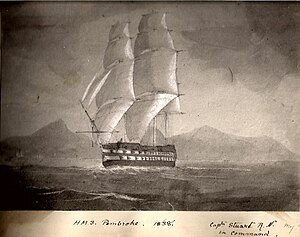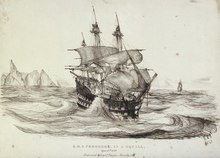HMS Pembroke (1812)

| |
| History | |
|---|---|
| Name | HMS Pembroke |
| Ordered | 17 May 1808 |
| Builder | Wigram, Wells & Green, Blackwall Yard |
| Laid down | March 1809 |
| Launched | 27 June 1812 |
| Fate | Sold, 1905 |
| General characteristics [1] | |
| Class and type | Vengeur-class ship of the line |
| Tons burthen | 1758 bm |
| Length | 176 ft (54 m) (gundeck) |
| Beam | 47 ft 6 in (14.48 m) |
| Depth of hold | 21 ft (6.4 m) |
| Propulsion | Sails |
| Sail plan | Full-rigged ship |
| Armament |
|
HMS Pembroke was a 74-gun third rate ship of the line of the Royal Navy, launched on 27 June 1812 at Blackwall Yard.[1]
Pembroke was driven ashore near Portsmouth in late December 1812 . She was refloated on 29 December 1812 by the frigates HMS Niobe and HMS Pomone and the ship-sloop HMS Rosamond.[2]
As a part of a squadron under the command of Sir James Brisbane Pembroke, in company with Alcmene and Aigle, on 11 April 1814 captured Fortune, Notre Dame de Leusainte, and a settee [1] of unknown name, at Fort Maurigio, in the Gulf of Genoa, near Monaco. The squadron silenced the fort's guns, and attacked 20 vessels; 4 were captured, and the cargoes of another 15 taken off ships whose crews scuttled them.[3][4][5][Note 1]
In 1836 Pembroke formed part of an experimental squadron, which were groups of ships sent out in the 1830s and 1840s to test new techniques of ship design, armament, building, and propulsion. In March 1837, she was driven ashore at Gibraltar, but she later was refloated with assistance from the French steamship Minos.[7][8]
Pembroke was fitted with screw propulsion in 1855.[1] On 16 September 1857, she ran down and sank the British brig Lady Sale off the Isle of May.[9] The Admiralty Court found Pembroke to blame for the collision.[10] She was transferred to the Coastguard in 1858, and used as a base ship from 1887. She was renamed HMS Forte as a receiving hulk in 1890, and was eventually sold out of the navy in 1905.[1]


Notes
[edit]Citations
[edit]- ^ a b c d Lavery, Ships of the Line vol.1, p189.
- ^ "Marine List". Lloyd's List (4733): 78 v. 9 January 1813.
- ^ "The squadron under the command of Sir J. Brisbane attacking Fort Maurigio. From a sketch by Sir J. Brisbane". grosvenorprints.com. Retrieved 30 June 2018.
- ^ "The Squadron under the command of Sir J Brisbane attacking Fort Maurigio. From a sketch by Sir J Brisbane". collections.rmg.co.uk. Retrieved 30 June 2018.
- ^ "No. 16943". The London Gazette. 8 October 1814. p. 2009.
- ^ "London". Caledonian Mercury. No. 18246. Edinburgh. 30 March 1837.
- ^ "(untitled)". The Morning Chronicle. No. 21025. London. 30 March 1837.
- ^ "Mercantile Ship News". The Standard. No. 10329. London. 21 September 1857. p. 8.
- ^ "Shipping Intelligence". The Aberdeen Journal. No. 5749. Aberdeen. 17 March 1858.
Publications
[edit]- Colledge, J. J.; Warlow, Ben (2006) [1969]. Ships of the Royal Navy: The Complete Record of all Fighting Ships of the Royal Navy (Rev. ed.). London: Chatham Publishing. ISBN 978-1-86176-281-8.
- Lavery, Brian (2003) The Ship of the Line - Volume 1: The development of the battlefleet 1650-1850. Conway Maritime Press. ISBN 0-85177-252-8.
External links
[edit] Media related to HMS Pembroke (ship, 1812) at Wikimedia Commons
Media related to HMS Pembroke (ship, 1812) at Wikimedia Commons
